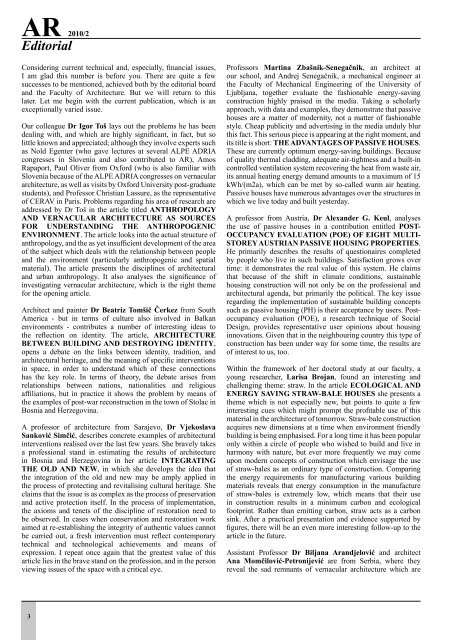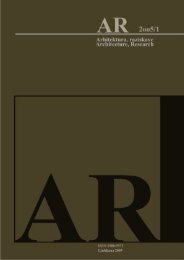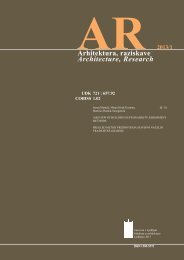AR 2010/2 - Fakulteta za arhitekturo
AR 2010/2 - Fakulteta za arhitekturo
AR 2010/2 - Fakulteta za arhitekturo
- No tags were found...
Create successful ePaper yourself
Turn your PDF publications into a flip-book with our unique Google optimized e-Paper software.
<strong>AR</strong> <strong>2010</strong>/2EditorialConsidering current technical and, especially, financial issues,I am glad this number is before you. There are quite a fewsuccesses to be mentioned, achieved both by the editorial boardand the Faculty of Architecture. But we will return to thislater. Let me begin with the current publication, which is anexceptionally varied issue.Our colleague Dr Igor Toš lays out the problems he has beendealing with, and which are highly significant, in fact, but solittle known and appreciated; although they involve experts suchas Nold Egenter (who gave lectures at several ALPE ADRIAcongresses in Slovenia and also contributed to <strong>AR</strong>), AmosRapaport, Paul Oliver from Oxford (who is also familiar withSlovenia because of the ALPE ADRIA congresses on vernaculararchitecture, as well as visits by Oxford University post-graduatestudents), and Professor Christian Lassure, as the representativeof CERAV in Paris. Problems regarding his area of research areaddressed by Dr Toš in the article titled ANTHROPOLOGYAND VERNACUL<strong>AR</strong> <strong>AR</strong>CHITECTURE AS SOURCESFOR UNDERSTANDING THE ANTHROPOGENICENVIRONMENT. The article looks into the actual structure ofanthropology, and the as yet insufficient development of the areaof the subject which deals with the relationship between peopleand the environment (particularly anthropogenic and spatialmaterial). The article presents the disciplines of architecturaland urban anthropology. It also analyses the significance ofinvestigating vernacular architecture, which is the right themefor the opening article.Architect and painter Dr Beatriz Tomšič Čerkez from SouthAmerica - but in terms of culture also involved in Balkanenvironments - contributes a number of interesting ideas tothe reflection on identity. The article, <strong>AR</strong>CHITECTUREBETWEEN BUILDING AND DESTROYING IDENTITY,opens a debate on the links between identity, tradition, andarchitectural heritage, and the meaning of specific interventionsin space, in order to understand which of these connectionshas the key role. In terms of theory, the debate arises fromrelationships between nations, nationalities and religiousaffiliations, but in practice it shows the problem by means ofthe examples of post-war reconstruction in the town of Stolac inBosnia and Herzegovina.A professor of architecture from Sarajevo, Dr VjekoslavaSanković Simčić, describes concrete examples of architecturalinterventions realised over the last few years. She bravely takesa professional stand in estimating the results of architecturein Bosnia and Herzegovina in her article INTEGRATINGTHE OLD AND NEW, in which she develops the idea thatthe integration of the old and new may be amply applied inthe process of protecting and revitalising cultural heritage. Sheclaims that the issue is as complex as the process of preservationand active protection itself. In the process of implementation,the axioms and tenets of the discipline of restoration need tobe observed. In cases when conservation and restoration workaimed at re-establishing the integrity of authentic values cannotbe carried out, a fresh intervention must reflect contemporarytechnical and technological achievements and means ofexpression. I repeat once again that the greatest value of thisarticle lies in the brave stand on the profession, and in the personviewing issues of the space with a critical eye.Professors Martina Zbašnik-Senegačnik, an architect atour school, and Andrej Senegačnik, a mechanical engineer atthe Faculty of Mechanical Engineering of the University ofLjubljana, together evaluate the fashionable energy-savingconstruction highly praised in the media. Taking a scholarlyapproach, with data and examples, they demonstrate that passivehouses are a matter of modernity, not a matter of fashionablestyle. Cheap publicity and advertising in the media unduly blurthis fact. This serious piece is appearing at the right moment, andits title is short: THE ADVANTAGES OF PASSIVE HOUSES.These are currently optimum energy-saving buildings. Becauseof quality thermal cladding, adequate air-tightness and a built-incontrolled ventilation system recovering the heat from waste air,its annual heating energy demand amounts to a maximum of 15kWh/(m2a), which can be met by so-called warm air heating.Passive houses have numerous advantages over the structures inwhich we live today and built yesterday.A professor from Austria, Dr Alexander G. Keul, analysesthe use of passive houses in a contribution entitled POST-OCCUPANCY EVALUATION (POE) OF EIGHT MULTI-STOREY AUSTRIAN PASSIVE HOUSING PROPERTIES.He primarily describes the results of questionaires completedby people who live in such buildings. Satisfaction grows overtime: it demonstrates the real value of this system. He claimsthat because of the shift in climate conditions, sustainablehousing construction will not only be on the professional andarchitectural agenda, but primarily the political. The key issueregarding the implementation of sustainable building conceptssuch as passive housing (PH) is their acceptance by users. Postoccupancyevaluation (POE), a research technique of SocialDesign, provides representative user opinions about housinginnovations. Given that in the neighbouring country this type ofconstruction has been under way for some time, the results areof interest to us, too.Within the framework of her doctoral study at our faculty, ayoung researcher, Larisa Brojan, found an interesting andchallenging theme: straw. In the article ECOLOGICAL ANDENERGY SAVING STRAW-BALE HOUSES she presents atheme which is not especially new, but points to quite a fewinteresting cues which might prompt the profitable use of thismaterial in the architecture of tomorrow. Straw-bale constructionacquires new dimensions at a time when environment friendlybuilding is being emphasised. For a long time it has been popularonly within a circle of people who wished to build and live inharmony with nature, but ever more frequently we may comeupon modern concepts of construction which envisage the useof straw-bales as an ordinary type of construction. Comparingthe energy requirements for manufacturing various buildingmaterials reveals that energy consumption in the manufactureof straw-bales is extremely low, which means that their usein construction results in a minimum carbon and ecologicalfootprint. Rather than emitting carbon, straw acts as a carbonsink. After a practical presentation and evidence supported byfigures, there will be an even more interesting follow-up to thearticle in the future.Assistant Professor Dr Biljana Arandjelović and architectAna Momčilović-Petronijević are from Serbia, where theyreveal the sad remnants of vernacular architecture which are3

















